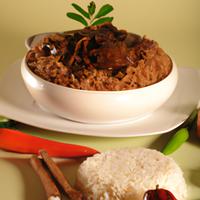
1 serving (200 grams) contains 250 calories, 5.0 grams of protein, 5.0 grams of fat, and 45.0 grams of carbohydrates.

Log this food in SnapCalorie

Nutrition Information
Calories |
294.1 | ||
|---|---|---|---|
% Daily Value* |
|||
| Total Fat | 5.9 g | 7% | |
| Saturated Fat | 1.2 g | 6% | |
| Polyunsaturated Fat | 0 g | ||
| Cholesterol | 0 mg | 0% | |
| Sodium | 470.6 mg | 20% | |
| Total Carbohydrates | 52.9 g | 19% | |
| Dietary Fiber | 2.4 g | 8% | |
| Sugars | 3.5 g | ||
| protein | 5.9 g | 11% | |
| Vitamin D | 0 mcg | 0% | |
| Calcium | 47.1 mg | 3% | |
| Iron | 1.8 mg | 10% | |
| Potassium | 176.5 mg | 3% | |
* Percent Daily Values are based on a 2,000 calorie diet. Your daily values may be higher or lower depending on your calorie needs.
Food Attributes
Source of Calories
About Tamarind rice
Tamarind Rice, or "Puliyodarai," is a traditional South Indian dish known for its tangy and spicy flavor. The dish features cooked rice mixed with tamarind pulp, aromatic spices, curry leaves, red chilies, and a seasoning of mustard seeds, peanuts, and sesame. This vibrant dish offers a balance of rich flavors, often complemented by its subtle nutty crunch. Tamarind, the core ingredient, is a good source of antioxidants and aids digestion, while peanuts provide healthy fats and protein. Typically low in saturated fats, the dish can be a wholesome choice when prepared with minimal oil. However, its sodium content may be high depending on the spice blend used, so moderation is key for those monitoring salt intake. Served as a main course, it’s a plant-based, nutrient-dense option that’s naturally gluten-free. Tamarind Rice is beloved for its tangy zest and comforting connection to Indian cuisine’s diverse vegetarian heritage.



